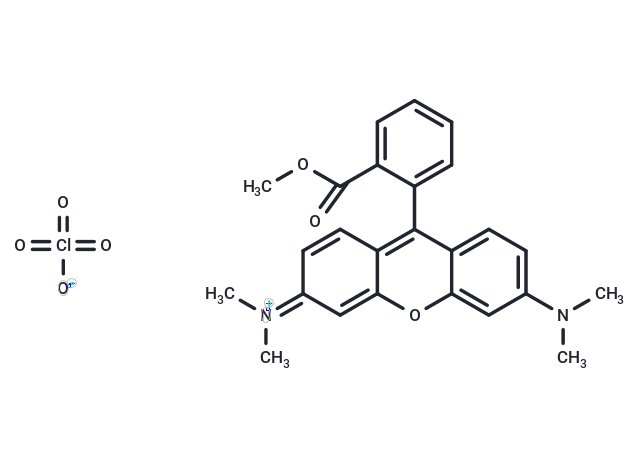Shopping Cart
Remove All Your shopping cart is currently empty
Your shopping cart is currently empty
TMRM Perchlorate (T668) is a cell-permeant cationic lipophilic red fluorescent dye (λex=530 nm, λem=592 nm).

| Pack Size | Price | USA Warehouse | Global Warehouse | Quantity |
|---|---|---|---|---|
| 5 mg | $39 | In Stock | In Stock | |
| 10 mg | $64 | In Stock | In Stock | |
| 25 mg | $123 | In Stock | In Stock | |
| 50 mg | $228 | In Stock | In Stock | |
| 100 mg | $372 | In Stock | In Stock | |
| 200 mg | $517 | - | In Stock | |
| 500 mg | $838 | - | In Stock | |
| 1 mL x 10 mM (in DMSO) | $43 | In Stock | In Stock |
| Description | TMRM Perchlorate (T668) is a cell-permeant cationic lipophilic red fluorescent dye (λex=530 nm, λem=592 nm). |
| In vitro | TMRM Perchlorate is a fluorescent probe (excitation, 530±21 nm; emission, 592±22 nm). The fluorescence signal in the presence of TMRM Perchlorate shows a slight decrease after the addition of glutamate, indicative of increased polarization of the mitochondrial inner membrane. In the presence of TMRM Perchlorate (2 μM) the coupled respiration with Complex I substrates or upon the addition of Complex II substrate is decreased by 27%[1]. Exposure of hippocampal cultures to low concentrations of TMRM Perchlorate (50 to 500 nM) for 1 to 3 hours results in selective staining of mitochondria in both neurons and the underlying glial cells. Exposure of hippocampal cultures to high concentrations of TMRM Perchlorate (1 to 25 μM) stains mitochondria selectively and quickly, reaching a plateau after 5 to 10 min. Low concentrations of TMRM Perchlorate (50 to 200 nM) do not induce apoptosis, whereas higher concentrations (0.5 and 2.5 μM) enhance apoptosis (KD?=?500 nM)[2]. |
| Cell Research | 1. Mitochondrial membrane potential measurement Experimental steps: 1. Prepare TMRM solution: Dissolve TMRM Perchlorate (T668) in DMSO to prepare a stock solution (usually 1 mM). The stock solution is then diluted to a working concentration, usually between 10 nM and 200 nM, depending on the experimental requirements. 2. Cell incubation: Add TMRM solution to the cells and incubate at 37°C for 20-30 minutes. During this time, the dye enters the cells and accumulates in the mitochondria, and the dye emits a red fluorescence. 3. Wash (optional): After incubation, wash the cells with fresh culture medium or PBS to remove excess dye. 4. Fluorescence measurement: Fluorescence measurement is performed using a fluorescence microscope or flow cytometry, with the excitation wavelength of 530 nm and the emission wavelength of 592 nm. The fluorescence intensity reflects the mitochondrial membrane potential. 5. Data analysis: High fluorescence intensity indicates a higher mitochondrial membrane potential, while a decrease in fluorescence intensity indicates a loss of mitochondrial membrane potential. 2. Research on apoptosis and mitochondrial dysfunction Experimental steps: 1. Treat cells: Treat cells with apoptosis inducers, mitochondrial uncoupling agents, or other chemicals that may affect mitochondrial membrane potential. 2. Add TMRM solution: Add TMRM dye to the treated cells and incubate for 20-30 minutes. 3. Fluorescence measurement: Measure the fluorescence intensity according to the above method. A decrease in fluorescence intensity indicates a decrease in mitochondrial membrane potential, which may indicate that the cells are undergoing apoptosis or stress. 4. Results analysis: Analyze the changes in fluorescence intensity. If the fluorescence intensity is significantly reduced, it indicates a loss of mitochondrial membrane potential, which is one of the hallmarks of apoptosis. Notes: 1. Concentration optimization: The optimal working concentration of TMRM may vary by cell type. It is recommended to determine the optimal concentration through experiments. 2. Live cell staining: TMRM is used for live cell staining. The cells need to be gently treated during operation to avoid destroying the mitochondrial structure during the washing step. 3. Avoid photobleaching: TMRM is sensitive to photobleaching. Light exposure should be minimized during sample processing and imaging to ensure reliable results. 4. Control experiments: Appropriate controls should be included in the experiment, such as treating cells with mitochondrial uncoupling agents (such as FCCP), which can serve as a positive control for loss of mitochondrial membrane potential. |
| Synonyms | T668 |
| Molecular Weight | 500.93 |
| Formula | C25H25ClN2O7 |
| Cas No. | 115532-50-8 |
| Smiles | [O-][Cl](=O)(=O)=O.COC(=O)c1ccccc1-c1c2ccc(cc2oc2cc(ccc12)=[N+](C)C)N(C)C |
| Relative Density. | no data available |
| Color | Green |
| Appearance | solid |
| Storage | keep away from direct sunlight | Powder: -20°C for 3 years | In solvent: -80°C for 1 year | Shipping with blue ice/Shipping at ambient temperature. | ||||||||||||||||||||||||||||||
| Solubility Information | DMSO: 50 mg/mL (99.81 mM), Sonication is recommended. | ||||||||||||||||||||||||||||||
Solution Preparation Table | |||||||||||||||||||||||||||||||
DMSO
| |||||||||||||||||||||||||||||||
| Size | Quantity | Unit Price | Amount | Operation |
|---|

Copyright © 2015-2026 TargetMol Chemicals Inc. All Rights Reserved.